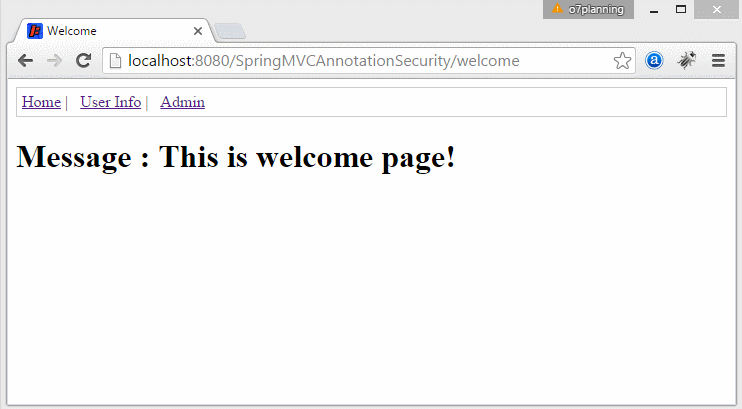Einfache Anmeldung Java Web Application mit Spring MVC, Spring Security und Spring JDBC
2. Database vorbereiten
- ORACLE:
-- Create table
create table USERS
(
USERNAME VARCHAR2(36) not null,
PASSWORD VARCHAR2(36) not null,
ENABLED NUMBER(1) not null
) ;
alter table USERS
add constraint USER_PK primary key (USERNAME);
---------------------
-- Create table
create table USER_ROLES
(
ROLE_ID VARCHAR2(50) not null,
USERNAME VARCHAR2(36) not null,
USER_ROLE VARCHAR2(30) not null
) ;
alter table USER_ROLES
add constraint USER_ROLE_PK primary key (ROLE_ID);
alter table USER_ROLES
add constraint USER_ROLE_UK unique (USERNAME, USER_ROLE);
-------------------------------
insert into users (USERNAME, PASSWORD, ENABLED)
values ('dbuser1', '12345', 1);
insert into users (USERNAME, PASSWORD, ENABLED)
values ('dbadmin1', '12345', 1);
insert into User_Roles (ROLE_ID, USERNAME, USER_ROLE)
values ('1', 'dbuser1', 'USER');
insert into User_Roles (ROLE_ID, USERNAME, USER_ROLE)
values ('2', 'dbadmin1', 'ADMIN');
insert into User_Roles (ROLE_ID, USERNAME, USER_ROLE)
values ('3', 'dbadmin1', 'USER');
-------------------------------
Commit;- MySQL & SQL Server:
-- Create table
create table USERS
(
USERNAME VARCHAR(36) not null,
PASSWORD VARCHAR(36) not null,
ENABLED smallint not null
) ;
alter table USERS
add constraint USER_PK primary key (USERNAME);
---------------------
-- Create table
create table USER_ROLES
(
ROLE_ID VARCHAR(50) not null,
USERNAME VARCHAR(36) not null,
USER_ROLE VARCHAR(30) not null
) ;
alter table USER_ROLES
add constraint USER_ROLE_PK primary key (ROLE_ID);
alter table USER_ROLES
add constraint USER_ROLE_UK unique (USERNAME, USER_ROLE);
-------------------------------
insert into users (USERNAME, PASSWORD, ENABLED)
values ('dbuser1', '12345', 1);
insert into users (USERNAME, PASSWORD, ENABLED)
values ('dbadmin1', '12345', 1);
insert into User_Roles (ROLE_ID, USERNAME, USER_ROLE)
values ('1', 'dbuser1', 'USER');
insert into User_Roles (ROLE_ID, USERNAME, USER_ROLE)
values ('2', 'dbadmin1', 'ADMIN');
insert into User_Roles (ROLE_ID, USERNAME, USER_ROLE)
values ('3', 'dbadmin1', 'USER');3. Das Projekt erstellen
- File/New/Other...

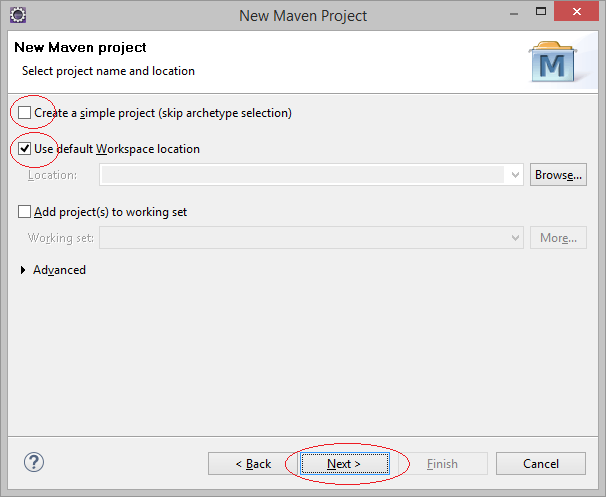

Geben Sie ein
- Group ID: org.o7planning
- Artifact ID: SpringMVCAnnotationSecurity
- Package: org.o7planning.tutorial.springmvcsecurity
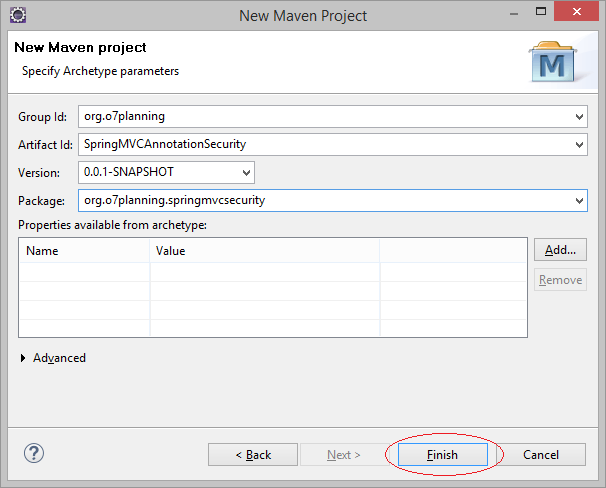
Das Projekt wird erstellt

Sie sollen keine Sorge für die Fehleranmeldung haben wenn das Projekt erstellt wird. Der Grund liegt darin, Sie erklärt die Bibliothek Servlet nicht.
Die Struktur von Projekt ändern
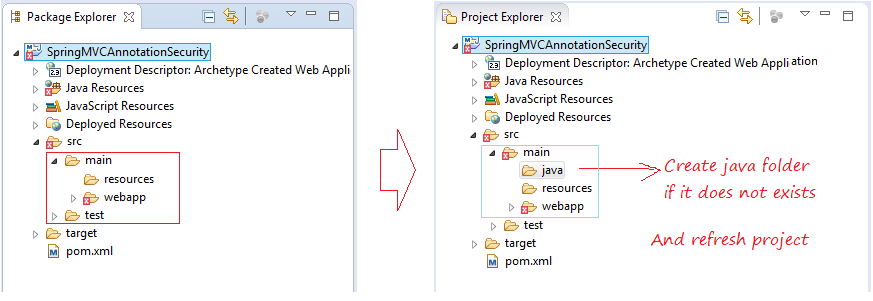
Die File index.jsp sehen
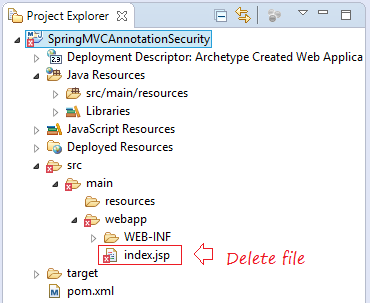
Klicken Sie die Rechtmaustaste auf Projekt und wählen Sie Properties:
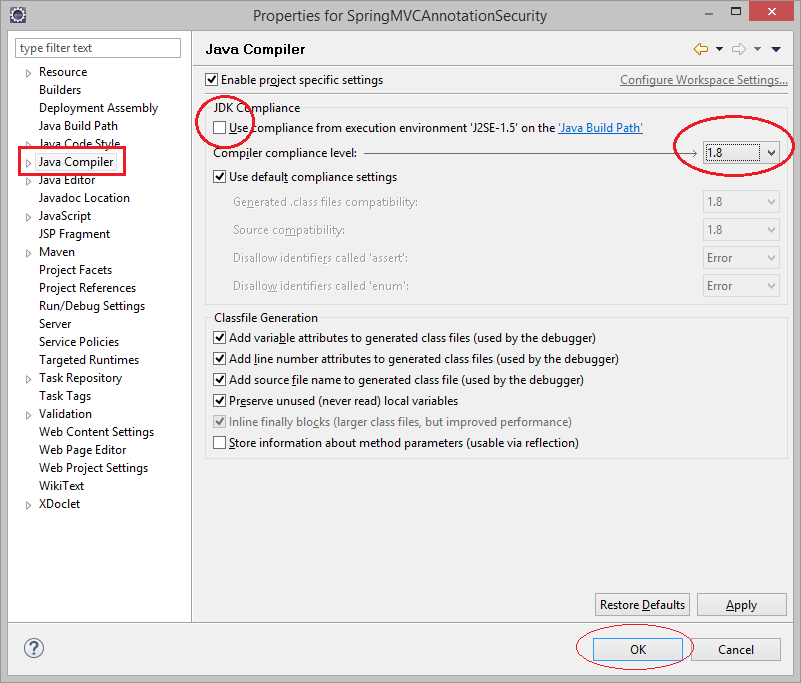
4. Maven & web.xml konfigurieren
WebApp 3.x.konfigurieren
web.xml
<?xml version="1.0" encoding="UTF-8"?>
<web-app xmlns:xsi="http://www.w3.org/2001/XMLSchema-instance"
xmlns="http://java.sun.com/xml/ns/javaee"
xsi:schemaLocation="http://java.sun.com/xml/ns/javaee
http://java.sun.com/xml/ns/javaee/web-app_3_0.xsd"
id="WebApp_ID" version="3.0">
<display-name>Spring MVC Security</display-name>
</web-app>Maven:
pom.xml
<project xmlns="http://maven.apache.org/POM/4.0.0"
xmlns:xsi="http://www.w3.org/2001/XMLSchema-instance"
xsi:schemaLocation="http://maven.apache.org/POM/4.0.0
http://maven.apache.org/maven-v4_0_0.xsd">
<modelVersion>4.0.0</modelVersion>
<groupId>org.o7planning</groupId>
<artifactId>SpringMVCAnnotationSecurity</artifactId>
<packaging>war</packaging>
<version>0.0.1-SNAPSHOT</version>
<name>SpringMVCAnnotationSecurity Maven Webapp</name>
<url>http://maven.apache.org</url>
<properties>
<!-- Generic properties -->
<java.version>1.7</java.version>
<project.build.sourceEncoding>UTF-8</project.build.sourceEncoding>
<project.reporting.outputEncoding>UTF-8</project.reporting.outputEncoding>
</properties>
<repositories>
<!-- Repository for ORACLE JDBC Driver -->
<repository>
<id>codelds</id>
<url>https://code.lds.org/nexus/content/groups/main-repo</url>
</repository>
</repositories>
<dependencies>
<!-- Spring framework START -->
<!-- http://mvnrepository.com/artifact/org.springframework/spring-core -->
<dependency>
<groupId>org.springframework</groupId>
<artifactId>spring-core</artifactId>
<version>4.2.5.RELEASE</version>
</dependency>
<!-- http://mvnrepository.com/artifact/org.springframework/spring-web -->
<dependency>
<groupId>org.springframework</groupId>
<artifactId>spring-web</artifactId>
<version>4.2.5.RELEASE</version>
</dependency>
<!-- http://mvnrepository.com/artifact/org.springframework/spring-webmvc -->
<dependency>
<groupId>org.springframework</groupId>
<artifactId>spring-webmvc</artifactId>
<version>4.2.5.RELEASE</version>
</dependency>
<!-- http://mvnrepository.com/artifact/org.springframework/spring-jdbc -->
<dependency>
<groupId>org.springframework</groupId>
<artifactId>spring-jdbc</artifactId>
<version>4.2.5.RELEASE</version>
</dependency>
<!-- Spring framework END -->
<!-- Spring Security Artifacts - START -->
<!-- http://mvnrepository.com/artifact/org.springframework.security/spring-security-web -->
<dependency>
<groupId>org.springframework.security</groupId>
<artifactId>spring-security-web</artifactId>
<version>4.0.4.RELEASE</version>
</dependency>
<!-- http://mvnrepository.com/artifact/org.springframework.security/spring-security-config -->
<dependency>
<groupId>org.springframework.security</groupId>
<artifactId>spring-security-config</artifactId>
<version>4.0.4.RELEASE</version>
</dependency>
<!-- Spring Security Artifacts - END -->
<!-- Jstl for jsp page -->
<!-- http://mvnrepository.com/artifact/javax.servlet/jstl -->
<dependency>
<groupId>javax.servlet</groupId>
<artifactId>jstl</artifactId>
<version>1.2</version>
</dependency>
<!-- Servlet API -->
<!-- http://mvnrepository.com/artifact/javax.servlet/javax.servlet-api -->
<dependency>
<groupId>javax.servlet</groupId>
<artifactId>javax.servlet-api</artifactId>
<version>3.1.0</version>
<scope>provided</scope>
</dependency>
<!-- JSP API -->
<!-- http://mvnrepository.com/artifact/javax.servlet.jsp/jsp-api -->
<dependency>
<groupId>javax.servlet.jsp</groupId>
<artifactId>jsp-api</artifactId>
<version>2.2</version>
<scope>provided</scope>
</dependency>
<!-- MySQL JDBC driver -->
<!-- http://mvnrepository.com/artifact/mysql/mysql-connector-java -->
<dependency>
<groupId>mysql</groupId>
<artifactId>mysql-connector-java</artifactId>
<version>5.1.34</version>
</dependency>
<!-- Oracle JDBC driver -->
<dependency>
<groupId>com.oracle</groupId>
<artifactId>ojdbc6</artifactId>
<version>11.2.0.3</version>
</dependency>
<!-- SQLServer JDBC driver (JTDS) -->
<!-- http://mvnrepository.com/artifact/net.sourceforge.jtds/jtds -->
<dependency>
<groupId>net.sourceforge.jtds</groupId>
<artifactId>jtds</artifactId>
<version>1.3.1</version>
</dependency>
</dependencies>
<build>
<finalName>SpringMVCAnnotationSecurity</finalName>
<plugins>
<!-- Config: Maven Tomcat Plugin -->
<!-- http://mvnrepository.com/artifact/org.apache.tomcat.maven/tomcat7-maven-plugin -->
<plugin>
<groupId>org.apache.tomcat.maven</groupId>
<artifactId>tomcat7-maven-plugin</artifactId>
<version>2.2</version>
<!-- Config: contextPath and Port (Default: /SpringMVCAnnotationSecurity : 8080) -->
<!--
<configuration>
<path>/</path>
<port>8899</port>
</configuration>
-->
</plugin>
</plugins>
</build>
</project>5. Spring MVC & Security konfigurieren

SpringWebAppInitializer.java
package org.o7planning.springmvcsecurity.config;
import javax.servlet.ServletContext;
import javax.servlet.ServletException;
import javax.servlet.ServletRegistration;
import org.springframework.web.WebApplicationInitializer;
import org.springframework.web.context.support.AnnotationConfigWebApplicationContext;
import org.springframework.web.servlet.DispatcherServlet;
public class SpringWebAppInitializer implements WebApplicationInitializer {
@Override
public void onStartup(ServletContext servletContext) throws ServletException {
AnnotationConfigWebApplicationContext appContext = new AnnotationConfigWebApplicationContext();
appContext.register(ApplicationContextConfig.class);
ServletRegistration.Dynamic dispatcher = servletContext.addServlet("SpringDispatcher",
new DispatcherServlet(appContext));
dispatcher.setLoadOnStartup(1);
dispatcher.addMapping("/");
}
}Die Klasse ApplicationContextConfig wird benutzt um die Inhalt vonSpring MVC zu konfiguriren, einschließend:
- DataSource
- Transaction Manager
- Beans
- ...
ApplicationContextConfig.java
package org.o7planning.springmvcsecurity.config;
import javax.sql.DataSource;
import org.o7planning.springmvcsecurity.dao.UserInfoDAO;
import org.springframework.beans.factory.annotation.Autowired;
import org.springframework.context.annotation.Bean;
import org.springframework.context.annotation.ComponentScan;
import org.springframework.context.annotation.Configuration;
import org.springframework.context.annotation.Import;
import org.springframework.context.annotation.PropertySource;
import org.springframework.context.support.ResourceBundleMessageSource;
import org.springframework.core.env.Environment;
import org.springframework.jdbc.datasource.DataSourceTransactionManager;
import org.springframework.jdbc.datasource.DriverManagerDataSource;
import org.springframework.transaction.annotation.EnableTransactionManagement;
import org.springframework.web.servlet.view.InternalResourceViewResolver;
@Configuration
@ComponentScan("org.o7planning.springmvcsecurity.*")
@EnableTransactionManagement
// Load to Environment.
@PropertySource("classpath:datasource-cfg.properties")
public class ApplicationContextConfig {
// The Environment class serves as the property holder
// and stores all the properties loaded by the @PropertySource
@Autowired
private Environment env;
@Autowired
private UserInfoDAO userInfoDAO;
@Bean
public ResourceBundleMessageSource messageSource() {
ResourceBundleMessageSource rb = new ResourceBundleMessageSource();
// Load property in message/validator.properties
rb.setBasenames(new String[] { "messages/validator" });
return rb;
}
@Bean(name = "viewResolver")
public InternalResourceViewResolver getViewResolver() {
InternalResourceViewResolver viewResolver = new InternalResourceViewResolver();
viewResolver.setPrefix("/WEB-INF/pages/");
viewResolver.setSuffix(".jsp");
return viewResolver;
}
@Bean(name = "dataSource")
public DataSource getDataSource() {
DriverManagerDataSource dataSource = new DriverManagerDataSource();
// See: datasouce-cfg.properties
dataSource.setDriverClassName(env.getProperty("ds.database-driver"));
dataSource.setUrl(env.getProperty("ds.url"));
dataSource.setUsername(env.getProperty("ds.username"));
dataSource.setPassword(env.getProperty("ds.password"));
System.out.println("## getDataSource: " + dataSource);
return dataSource;
}
// Transaction Manager
@Autowired
@Bean(name = "transactionManager")
public DataSourceTransactionManager getTransactionManager(DataSource dataSource) {
DataSourceTransactionManager transactionManager = new DataSourceTransactionManager(dataSource);
return transactionManager;
}
}ApplicationContextConfig wird die File datasouce-cfg.xml lesen:
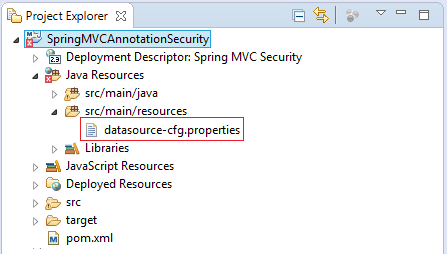
datasouce-cfg.properties (For Oracle)
# DataSource
ds.database-driver=oracle.jdbc.driver.OracleDriver
ds.url=jdbc:oracle:thin:@localhost:1521:db12c
ds.username=test
ds.password=12345datasource-cfg.properties (For SQL Server)
# DataSource
ds.database-driver=net.sourceforge.jtds.jdbc.Driver
ds.url=jdbc:jtds:sqlserver://localhost:1433/simplehr;instance=SQLEXPRESS
ds.username=test
ds.password=12345datasource-cfg.properties (For MySQL)
# DataSource
ds.database-driver=com.mysql.jdbc.Driver
ds.url=jdbc:mysql://localhost:3306/mydatabase
ds.username=root
ds.password=12345WebMvcConfig.java
package org.o7planning.springmvcsecurity.config;
import java.nio.charset.Charset;
import java.util.Arrays;
import java.util.List;
import org.springframework.context.annotation.Configuration;
import org.springframework.http.MediaType;
import org.springframework.http.converter.HttpMessageConverter;
import org.springframework.http.converter.StringHttpMessageConverter;
import org.springframework.web.servlet.config.annotation.DefaultServletHandlerConfigurer;
import org.springframework.web.servlet.config.annotation.EnableWebMvc;
import org.springframework.web.servlet.config.annotation.ResourceHandlerRegistry;
import org.springframework.web.servlet.config.annotation.WebMvcConfigurerAdapter;
@Configuration
@EnableWebMvc
public class WebMvcConfig extends WebMvcConfigurerAdapter {
private static final Charset UTF8 = Charset.forName("UTF-8");
// Config UTF-8 Encoding.
@Override
public void configureMessageConverters(List<HttpMessageConverter<?>> converters) {
StringHttpMessageConverter stringConverter = new StringHttpMessageConverter();
stringConverter.setSupportedMediaTypes(Arrays.asList(new MediaType("text", "plain", UTF8)));
converters.add(stringConverter);
// Add other converters ...
}
// Static Resource Config
// equivalents for <mvc:resources/> tags
@Override
public void addResourceHandlers(ResourceHandlerRegistry registry) {
registry.addResourceHandler("/css/**").addResourceLocations("/css/").setCachePeriod(31556926);
registry.addResourceHandler("/img/**").addResourceLocations("/img/").setCachePeriod(31556926);
registry.addResourceHandler("/js/**").addResourceLocations("/js/").setCachePeriod(31556926);
}
// Equivalent for <mvc:default-servlet-handler/> tag
@Override
public void configureDefaultServletHandling(DefaultServletHandlerConfigurer configurer) {
configurer.enable();
}
}SpringSecurityInitializer.java
package org.o7planning.springmvcsecurity.config;
import org.springframework.security.web.context.AbstractSecurityWebApplicationInitializer;
public class SpringSecurityInitializer extends AbstractSecurityWebApplicationInitializer {
// Do nothing
}WebSecurityConfig.java
package org.o7planning.springmvcsecurity.config;
import org.o7planning.springmvcsecurity.authentication.MyDBAuthenticationService;
import org.springframework.beans.factory.annotation.Autowired;
import org.springframework.context.annotation.Configuration;
import org.springframework.security.config.annotation.authentication.builders.AuthenticationManagerBuilder;
import org.springframework.security.config.annotation.web.builders.HttpSecurity;
import org.springframework.security.config.annotation.web.configuration.EnableWebSecurity;
import org.springframework.security.config.annotation.web.configuration.WebSecurityConfigurerAdapter;
@Configuration
// @EnableWebSecurity = @EnableWebMVCSecurity + Extra features
@EnableWebSecurity
public class WebSecurityConfig extends WebSecurityConfigurerAdapter {
@Autowired
MyDBAuthenticationService myDBAauthenticationService;
@Autowired
public void configureGlobal(AuthenticationManagerBuilder auth) throws Exception {
// Users in memory.
auth.inMemoryAuthentication().withUser("user1").password("12345").roles("USER");
auth.inMemoryAuthentication().withUser("admin1").password("12345").roles("USER, ADMIN");
// For User in database.
auth.userDetailsService(myDBAauthenticationService);
}
@Override
protected void configure(HttpSecurity http) throws Exception {
http.csrf().disable();
// The pages does not require login
http.authorizeRequests().antMatchers("/", "/welcome", "/login", "/logout").permitAll();
// /userInfo page requires login as USER or ADMIN.
// If no login, it will redirect to /login page.
http.authorizeRequests().antMatchers("/userInfo").access("hasAnyRole('ROLE_USER', 'ROLE_ADMIN')");
// For ADMIN only.
http.authorizeRequests().antMatchers("/admin").access("hasRole('ROLE_ADMIN')");
// When the user has logged in as XX.
// But access a page that requires role YY,
// AccessDeniedException will throw.
http.authorizeRequests().and().exceptionHandling().accessDeniedPage("/403");
// Config for Login Form
http.authorizeRequests().and().formLogin()//
// Submit URL of login page.
.loginProcessingUrl("/j_spring_security_check") // Submit URL
.loginPage("/login")//
.defaultSuccessUrl("/userInfo")//
.failureUrl("/login?error=true")//
.usernameParameter("username")//
.passwordParameter("password")
// Config for Logout Page
.and().logout().logoutUrl("/logout").logoutSuccessUrl("/logoutSuccessful");
}
}6. Die Klasse zur Teilnahme an der Sicherheit (Security)
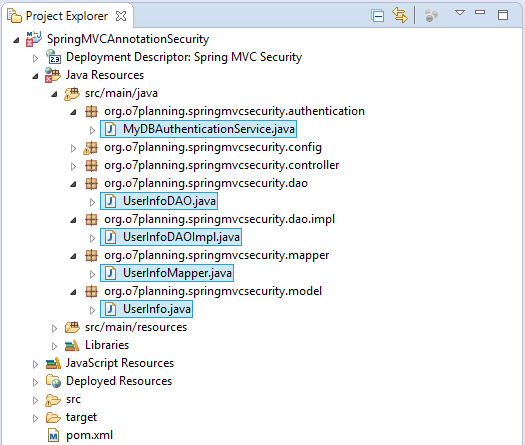
Die Klasse UserInfo ist äquivalent mit der Tabelle USERS in Database
UserInfo.java
package org.o7planning.springmvcsecurity.model;
public class UserInfo {
private String userName;
private String password;
public UserInfo() {
}
public UserInfo(String userName, String password) {
this.userName = userName;
this.password = password;
}
public String getUserName() {
return userName;
}
public void setUserName(String userName) {
this.userName = userName;
}
public String getPassword() {
return password;
}
public void setPassword(String password) {
this.password = password;
}
}Die Klasse UserInfoMapper benutzt um die Spalte im Befehl SQL äquivalent mit den Felder von Klasse UserInfo abzubilden
UserInfoMapper.java
package org.o7planning.springmvcsecurity.mapper;
import java.sql.ResultSet;
import java.sql.SQLException;
import org.o7planning.springmvcsecurity.model.UserInfo;
import org.springframework.jdbc.core.RowMapper;
public class UserInfoMapper implements RowMapper<UserInfo> {
@Override
public UserInfo mapRow(ResultSet rs, int rowNum) throws SQLException {
String userName = rs.getString("Username");
String password = rs.getString("Password");
return new UserInfo(userName, password);
}
}UserInfoDAO.java
package org.o7planning.springmvcsecurity.dao;
import java.util.List;
import org.o7planning.springmvcsecurity.model.UserInfo;
public interface UserInfoDAO {
public UserInfo findUserInfo(String userName);
// [USER,AMIN,..]
public List<String> getUserRoles(String userName);
}UserInfoDAOImpl.java
package org.o7planning.springmvcsecurity.dao.impl;
import java.util.List;
import javax.sql.DataSource;
import org.o7planning.springmvcsecurity.dao.UserInfoDAO;
import org.o7planning.springmvcsecurity.mapper.UserInfoMapper;
import org.o7planning.springmvcsecurity.model.UserInfo;
import org.springframework.beans.factory.annotation.Autowired;
import org.springframework.dao.EmptyResultDataAccessException;
import org.springframework.jdbc.core.support.JdbcDaoSupport;
import org.springframework.stereotype.Service;
import org.springframework.transaction.annotation.Transactional;
@Service
@Transactional
public class UserInfoDAOImpl extends JdbcDaoSupport implements UserInfoDAO {
@Autowired
public UserInfoDAOImpl(DataSource dataSource) {
this.setDataSource(dataSource);
}
@Override
public UserInfo findUserInfo(String userName) {
String sql = "Select u.Username,u.Password "//
+ " from Users u where u.Username = ? ";
Object[] params = new Object[] { userName };
UserInfoMapper mapper = new UserInfoMapper();
try {
UserInfo userInfo = this.getJdbcTemplate().queryForObject(sql, params, mapper);
return userInfo;
} catch (EmptyResultDataAccessException e) {
return null;
}
}
@Override
public List<String> getUserRoles(String userName) {
String sql = "Select r.User_Role "//
+ " from User_Roles r where r.Username = ? ";
Object[] params = new Object[] { userName };
List<String> roles = this.getJdbcTemplate().queryForList(sql,params, String.class);
return roles;
}
}Die Klasse MyDBAuthenticationService ist für die Anpassung der Bestätigung. Sie implementiert die Interface AuthenticationService.
MyDBAuthenticationService.java
package org.o7planning.springmvcsecurity.authentication;
import java.util.ArrayList;
import java.util.List;
import org.o7planning.springmvcsecurity.dao.UserInfoDAO;
import org.o7planning.springmvcsecurity.model.UserInfo;
import org.springframework.beans.factory.annotation.Autowired;
import org.springframework.security.core.GrantedAuthority;
import org.springframework.security.core.authority.SimpleGrantedAuthority;
import org.springframework.security.core.userdetails.User;
import org.springframework.security.core.userdetails.UserDetails;
import org.springframework.security.core.userdetails.UserDetailsService;
import org.springframework.security.core.userdetails.UsernameNotFoundException;
import org.springframework.stereotype.Service;
@Service
public class MyDBAuthenticationService implements UserDetailsService {
@Autowired
private UserInfoDAO userInfoDAO;
@Override
public UserDetails loadUserByUsername(String username) throws UsernameNotFoundException {
UserInfo userInfo = userInfoDAO.findUserInfo(username);
System.out.println("UserInfo= " + userInfo);
if (userInfo == null) {
throw new UsernameNotFoundException("User " + username + " was not found in the database");
}
// [USER,ADMIN,..]
List<String> roles= userInfoDAO.getUserRoles(username);
List<GrantedAuthority> grantList= new ArrayList<GrantedAuthority>();
if(roles!= null) {
for(String role: roles) {
// ROLE_USER, ROLE_ADMIN,..
GrantedAuthority authority = new SimpleGrantedAuthority("ROLE_" + role);
grantList.add(authority);
}
}
UserDetails userDetails = (UserDetails) new User(userInfo.getUserName(), //
userInfo.getPassword(),grantList);
return userDetails;
}
}7. Spring MVC Controller
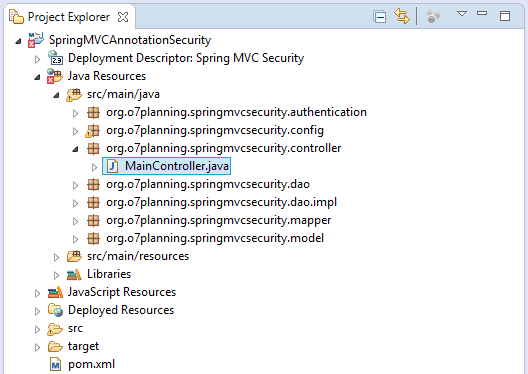
MainController.java
package org.o7planning.springmvcsecurity.controller;
import java.security.Principal;
import org.springframework.stereotype.Controller;
import org.springframework.ui.Model;
import org.springframework.web.bind.annotation.RequestMapping;
import org.springframework.web.bind.annotation.RequestMethod;
@Controller
public class MainController {
@RequestMapping(value = { "/", "/welcome" }, method = RequestMethod.GET)
public String welcomePage(Model model) {
model.addAttribute("title", "Welcome");
model.addAttribute("message", "This is welcome page!");
return "welcomePage";
}
@RequestMapping(value = "/admin", method = RequestMethod.GET)
public String adminPage(Model model) {
return "adminPage";
}
@RequestMapping(value = "/login", method = RequestMethod.GET)
public String loginPage(Model model ) {
return "loginPage";
}
@RequestMapping(value = "/logoutSuccessful", method = RequestMethod.GET)
public String logoutSuccessfulPage(Model model) {
model.addAttribute("title", "Logout");
return "logoutSuccessfulPage";
}
@RequestMapping(value = "/userInfo", method = RequestMethod.GET)
public String userInfo(Model model, Principal principal) {
// After user login successfully.
String userName = principal.getName();
System.out.println("User Name: "+ userName);
return "userInfoPage";
}
@RequestMapping(value = "/403", method = RequestMethod.GET)
public String accessDenied(Model model, Principal principal) {
if (principal != null) {
model.addAttribute("message", "Hi " + principal.getName()
+ "<br> You do not have permission to access this page!");
} else {
model.addAttribute("msg",
"You do not have permission to access this page!");
}
return "403Page";
}
}8. JSP Pages
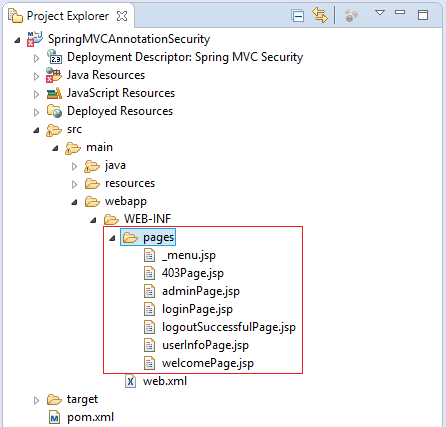
_menu.jsp
<%@taglib prefix="c" uri="http://java.sun.com/jsp/jstl/core"%>
<div style="border: 1px solid #ccc;padding:5px;margin-bottom:20px;">
<a href="${pageContext.request.contextPath}/welcome">Home</a>
|
<a href="${pageContext.request.contextPath}/userInfo">User Info</a>
|
<a href="${pageContext.request.contextPath}/admin">Admin</a>
<c:if test="${pageContext.request.userPrincipal.name != null}">
|
<a href="${pageContext.request.contextPath}/logout">Logout</a>
</c:if>
</div>403Page.jsp
<%@page session="false"%>
<html>
<head>
<title>Access Denied</title>
</head>
<body>
<jsp:include page="_menu.jsp"/>
<h3 style="color:red;">${message}</h3>
</body>
</html>adminPage.jsp
<%@taglib prefix="c" uri="http://java.sun.com/jsp/jstl/core"%>
<%@page session="true"%>
<html>
<head>
<title>${title}</title>
</head>
<body>
<jsp:include page="_menu.jsp" />
<h2>Admin Page</h2>
<h3>Welcome : ${pageContext.request.userPrincipal.name}</h3>
<b>This is protected page!</b>
</body>
</html>loginPage.jsp
<%@taglib prefix="c" uri="http://java.sun.com/jsp/jstl/core"%>
<html>
<head><title>Login</title></head>
<body>
<jsp:include page="_menu.jsp" />
<h1>Login</h1>
<!-- /login?error=true -->
<c:if test="${param.error == 'true'}">
<div style="color:red;margin:10px 0px;">
Login Failed!!!<br />
Reason : ${sessionScope["SPRING_SECURITY_LAST_EXCEPTION"].message}
</div>
</c:if>
<h3>Enter user name and password:</h3>
<form name='f' action="${pageContext.request.contextPath}/j_spring_security_check" method='POST'>
<table>
<tr>
<td>User:</td>
<td><input type='text' name='username' value=''></td>
</tr>
<tr>
<td>Password:</td>
<td><input type='password' name='password' /></td>
</tr>
<tr>
<td><input name="submit" type="submit" value="submit" /></td>
</tr>
</table>
</form>
</body>
</html>logoutSuccessfulPage.jsp
<html>
<head>
<title>Logout</title>
</head>
<body>
<jsp:include page="_menu.jsp" />
<h1>Logout Successful!</h1>
</body>
</html>userInfoPage.jsp
<%@page session="false"%>
<html>
<head>
<title>${title}</title>
</head>
<body>
<jsp:include page="_menu.jsp" />
<h1>Message : ${message}</h1>
</body>
</html>welcomePage.jsp
<%@page session="false"%>
<html>
<head>
<title>${title}</title>
</head>
<body>
<h1>Message : ${message}</h1>
</body>
</html>9. Die Konfiguration und das Laufen von der Applikation
Zum ersten Mal sollen Sie vor dem Laufen der Applikation das ganze Projekt bauen (build)
Klicken Sie die Rechtmaustaste auf Projekt und wählen Sie
- Run As/Maven install

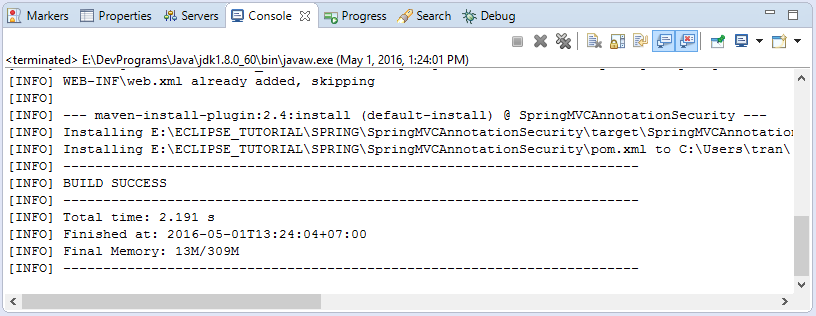
Zur Durchführung der Applikation konfigurieren
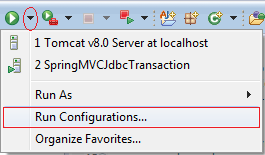
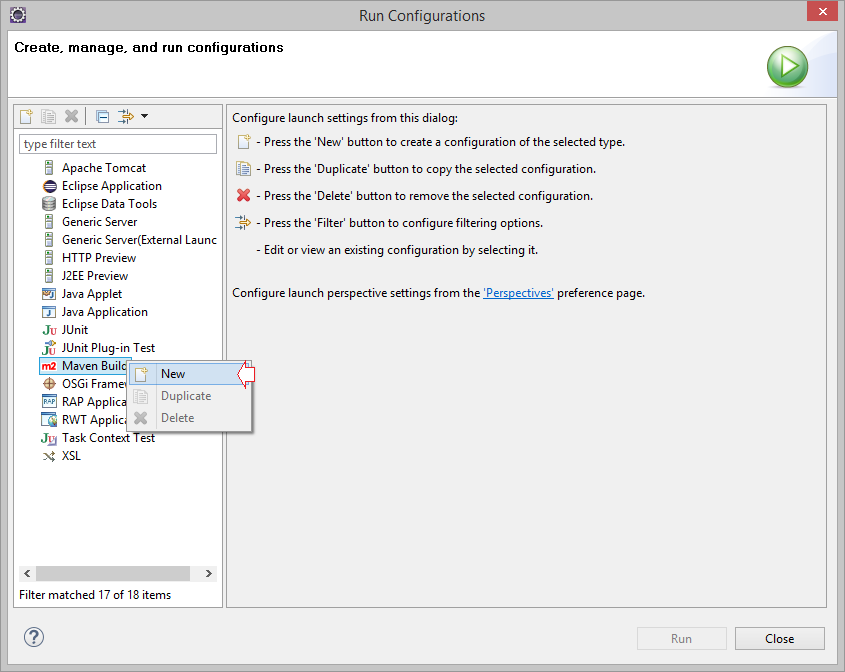
Geben Sie ein
- Name: Run SpringMVCSecurity
- Base directory: ${workspace_loc:/SpringMVCAnnotationSecurity}
- Goals: tomcat7:run
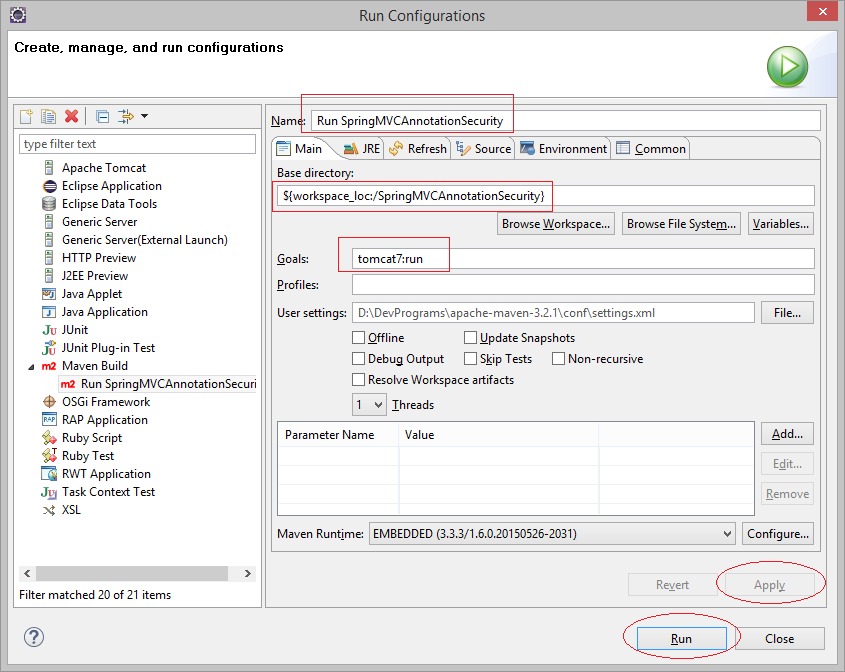
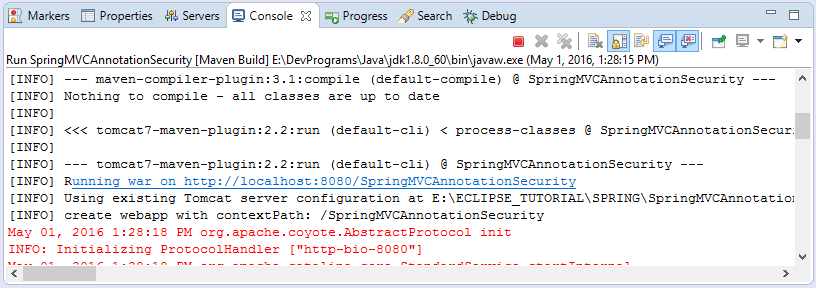
URL laufen:
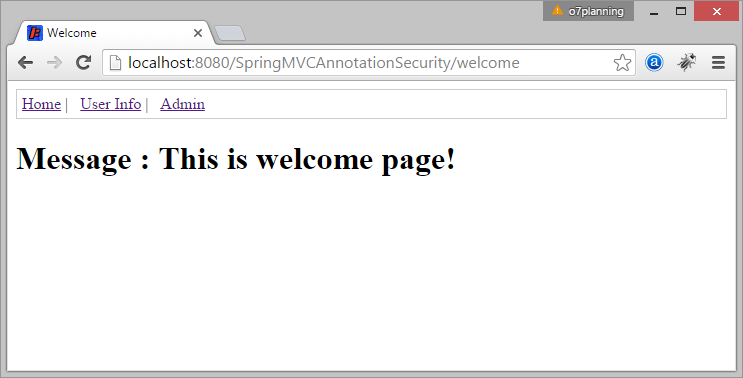
Typen Sie in den Pfad um die Information des user zu lesen. Falls Sie noch nocht login, wird die Website zur Login Seite weiterleiten

Wenn Sie die Information falsch eingeben und Submit klicken, wird die Website die Login Seite umleiten
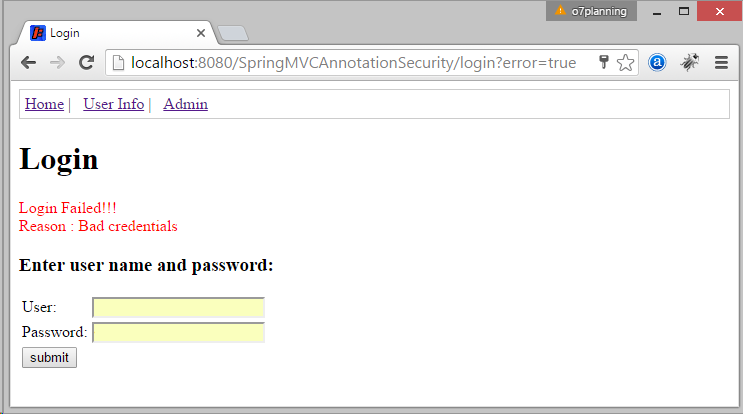
Falls das Login erfolgreich ist
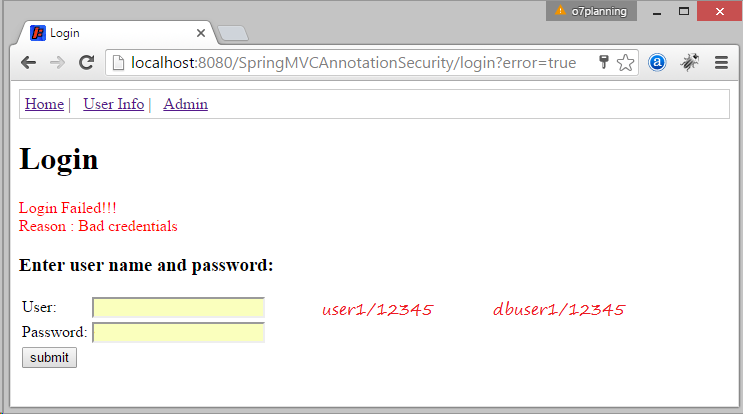
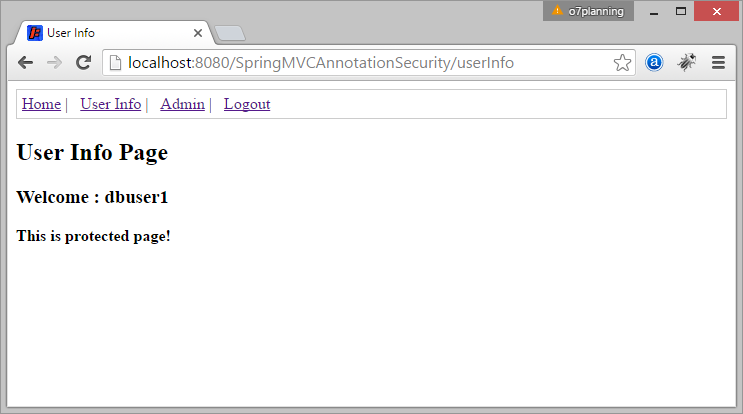
Sie können den Pfad versuchen
Der oben Pfad erlaubt, der User als ADMIN (ROLE_ADMIN) zugreiffen darf:
Falls Sie noch nicht angemeldet haben (login), wird die Website zur Login Seite umleiten. Wenn Sie als ROLE_USER anmelden, erhalten Sie die Benachrichtigung "Zugang verweigert" (Access Denied)
Falls Sie noch nicht angemeldet haben (login), wird die Website zur Login Seite umleiten. Wenn Sie als ROLE_USER anmelden, erhalten Sie die Benachrichtigung "Zugang verweigert" (Access Denied)

10. Fix Error!
Achtung: Wenn Sie den Fehler erhalten
HTTP Status 404 - /SpringMVCAnnotationSecurity/j_spring_security_check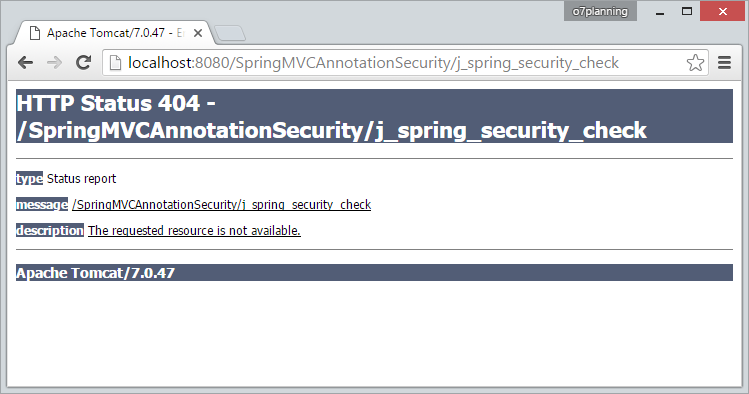
Stellen Sie sicher, dass Ihre Applikation die Klasse SpringSecurityInitializer hat:
SpringSecurityInitializer.java
package org.o7planning.springmvcsecurity.config;
import org.springframework.security.web.context.AbstractSecurityWebApplicationInitializer;
public class SpringSecurityInitializer extends AbstractSecurityWebApplicationInitializer {
// Do nothing
}Anleitungen Spring MVC
- Die Anleitung zum Sping für den Anfänger
- Installieren Sie die Spring Tool Suite für Eclipse
- Die Anleitung zum Sping MVC für den Anfänger - Hello Spring 4 MVC
- Konfigurieren Sie statische Ressourcen in Spring MVC
- Die Anleitung zu Spring MVC Interceptor
- Erstellen Sie eine mehr Sprachen Web-Anwendung mit Spring MVC
- Datei hochladen und herunterladen mit Spring MVC
- Einfache Anmeldung Java Web Application mit Spring MVC, Spring Security und Spring JDBC
- Social Login in Spring MVC mit Spring Social Security
- Die Anleitung zu Spring MVC mit FreeMarker
- Verwenden Sie Template in Spring MVC mit Apache Tiles
- Hướng dẫn sử dụng Spring MVC và Spring JDBC Transaction
- Verwenden Sie in Spring MVC mehrere DataSources
- Die Anleitung zu Spring MVC Form und Hibernate
- Führen Sie geplante Hintergrundaufgaben in Spring aus
- Erstellen Sie eine Java Shopping Cart Web Application mit Spring MVC und Hibernate
- Einfache CRUD Beispiel mit Spring MVC RESTful Web Service
- Stellen Sie Spring MVC auf Oracle WebLogic Server bereit
Show More
